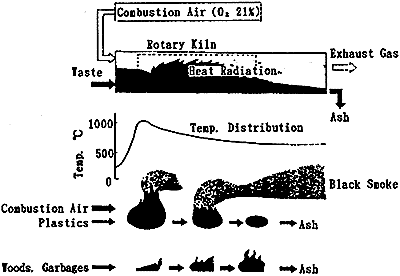Waste Treatment Technology in JAPAN
Drying, Incineration and Melting
2) It is unnecessary to prepare the various pretreatment facilities.
3) The inside area of the rotary kiln furnace is consisted of non metallic
material as castable refractories, therefore it is possible to prevent
from the melting troubles as stoker.
4) The rotary kiln furnace can be adapted to the various wastes as solid,
liquid and gas condition.
5) The rotary kiln furnace have a long retention time (30-60 min), therefore
it is easy to control the load fluctuation for suitable operation.
6) When the slagging type rotary kiln furnace are applied, the customers will
get the higher volume reduction rate and the possibilities of material
recycling for civil works.
* Conventional Combustion
* Gasificating Combustion.
1. Purpose
The rotary kiln furnace have been applied to incinerate the high calorie industrial Waste as plastics.
Using this type incinerator, the waste is effectively reduced the volume and changed the harmless residual.
For solid wastes, they are supplied to the rotary kiln furnace and feeder.
And they are transferred to the other side by the rotation and incline of the rotary kiln furnace. In this process, the wastes are decomposed by the heat radiation from after combustion chamber. The residual of this pyrolysis process are burned on the stokers, which are installed at the end of the rotary kiln furnace. And thermal decomposed gas is suitably incinerated in the after combustion chamber by using the multi stage combustion technologies.
For the low viscosity liquid wastes, they are injected into the after combustion chamber to evaporate the water and burn the volatile matters.
For the high viscosity liquid wastes, they are fed into the rotary kiln furnace with other solid wastes.
The exhaust gas from incineration is cooled by waste heat boiler and/or gas cooler, and introduced to the gas treatment facilities.
2. Characteristics
1) Gasification can achieve the low emission of harmful gas as NOx, soots
and so on.

